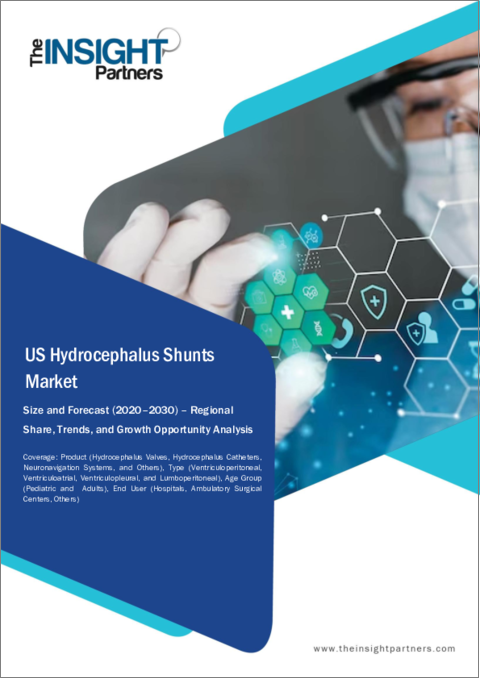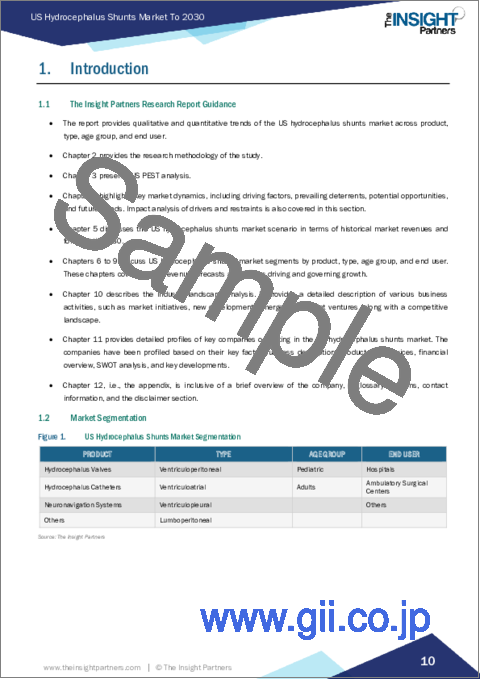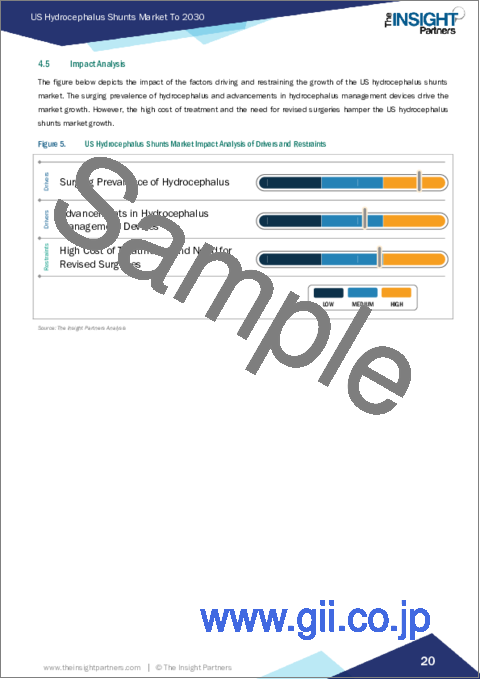|
|
市場調査レポート
商品コード
1372564
米国の水頭症シャント市場規模・予測、地域シェア、動向、成長機会分析レポート対象範囲:製品タイプ別、年齢層別、エンドユーザー別US Hydrocephalus Shunts Market Size and Forecasts, Regional Share, Trends, and Growth Opportunity Analysis Report Coverage: By Product, Type, Age Group, and End User |
||||||
|
|||||||
| 米国の水頭症シャント市場規模・予測、地域シェア、動向、成長機会分析レポート対象範囲:製品タイプ別、年齢層別、エンドユーザー別 |
|
出版日: 2023年10月10日
発行: The Insight Partners
ページ情報: 英文 68 Pages
納期: 即納可能
|
- 全表示
- 概要
- 図表
- 目次
米国の水頭症シャント市場規模は、2022年の1億900万米ドルから2030年には1億4,600万米ドルに達すると予測されます。2022年から2030年までのCAGRは3.7%で成長すると推定されます。
市場概要:
水頭症には、以下のような治療法がある:
シャントシステム:シャントシステム:これは一般的な治療法で、シャント(細い管)を埋め込み、余分な脳脊髄液を脳から吸収可能な別の部位に迂回させる。シャント技術の進歩により、その有効性が向上し、合併症が減少している可能性があります。
内視鏡的第3脳室切開術(ETV):これは、脳の第三脳室の底に小さな穴を開け、余分な脳脊髄液を流出させて吸収させる手術法です。ETVは非伝達性水頭症の特定の症例に用いられます。
カテーテルによる脳室瘻造設術:脳室に直接カテーテルを挿入して余分な脳脊髄液を排出する方法もあります。
脳室内内視鏡検査:内視鏡のような低侵襲技術の進歩により、水頭症のより正確な診断と治療が可能になっています。
水頭症治療のためのパートナーシップの増加
米国の水頭症シャント市場企業は、市場シェアを拡大するために合弁事業やパートナーシップなどの戦略を実施しています。2020年、Aesculap, Inc.はChristoph Miethke GmbH &Co.KG(MIETHKE)と提携し、米国でM.blue水頭症バルブの発売を発表しました。M.blue水頭症バルブは、固定差圧ユニットをバルブに組み込んだ独自のグラビティ技術により、患者の最も活動的な時間帯に、簡単かつ位置依存的に開口圧を調整することができます。多くの市場関係者が、経時的な流量や容積の把握が可能な「スマートシャント」の開発に注力しています。また、シャントの機能不全を診断するために、遠位カテーテルを通る流量を推定するために熱希釈を使用する装置を開発している業界パートナーもいくつかあります。このように、水頭症シャントのスマートな機能を支援するための提携の増加は、米国の水頭症シャント市場の今後の新たな動向につながると思われます。
シャントの品質向上のための調査の増加
研究者は、閉塞や感染症、その他の合併症のリスクを減らすために、改良されたシャント材料を開発しています。
抗菌コーティング:研究者は抗菌特性を持つシャント用コーティングを研究しています。これらのコーティングは、シャント留置時の感染リスクを軽減するのに役立ちます。
閉塞防止メカニズム:シャントの設計には、閉塞を防止または緩和する機能が組み込まれているものもあります。例えば、サイフォン防止機構を備えたバルブは、適切な流れを維持し、過排水や閉塞を防ぐのに役立ちます。
マグネットバルブ調整:一部のシャントシステムでは、磁石を使用して非侵襲的にバルブの設定を調整することで、繰り返し手術を行う必要性を減らしています。
生体適合素材:シャントの構造に生体適合素材を使用することで、アレルギー反応や体からのその他の有害反応のリスクを最小限に抑えることができます。
遠隔モニタリング:遠隔監視技術の進歩により、シャントの性能と頭蓋内圧を追跡できるようになり、医療従事者が問題が深刻化する前に特定できるようになりました。
ナノ技術:細菌付着に抵抗し、シャント全体の耐久性を向上させるシャント部品を作るために、ナノ技術の応用が検討されています。
例えば2021年、ペンシルベニア州立大学の研究者たちは、HydroFixと呼ばれる画期的な技術に積極的に取り組んできました。この革新的な外科用シャントシステムは、市場で入手可能な既存のシャント装置に伴う数々のリスクに対処するために特別に設計されています。その主な目的は、正常圧水頭症(NPH)患者に長期にわたる治療ソリューションを提供することです。この技術を発展させるため、研究者たちはCranial Devices Inc.という新興企業を設立しました。彼らは現在、ペンシルベニア州立大学からHydroFix技術のライセンスを取得しようとしているところです。
同様に、臨床段階の医療機器会社であるRhaeos, Inc.は、特許技術であるフローセンス(FlowSense)と非侵襲性のワイヤレス・ウェアラブル皮膚パッチを開発しています。FlowSenseはワイヤレスで非侵襲的な熱流量センサーであり、シャント上部の患者の頸部に装着することで、髄液の存在と大きさを検出します。FlowSenseを使用することで、シャントの機能をクリニック、入院患者、救急部でモニターすることができ、不必要な画像診断、入院期間、再入院費用を削減することができます。
米国の水頭症シャント市場セグメント別概要
米国の水頭症シャント市場の成長は、製品、タイプ、年齢層、エンドユーザーに区分されます。製品別では、水頭症バルブ、水頭症カテーテル、神経ナビゲーションシステム、その他に区分されます。水頭症バルブはさらに、圧力調整可能バルブ、固定圧力バルブに区分されます。タイプ別では、米国の水頭症シャント市場は脳室腹膜、脳室心耳、脳室神経、腰腹膜に区分されます。心室腹膜部門は2022年に市場をリードし、予測期間中もその優位性を維持すると予測されています。心室腹膜(VP)シャントは、脳室から腹膜腔(消化器官に近い腹部の溝)に髄液を迂回させることで、体液の蓄積によって脳にかかる圧力を軽減します。腹腔シャントは、水頭症の治療に最もよく使用されるシャントの一つです。米国立生物工学情報センター(NCBI)に掲載された調査論文によると、VPシャントは高度な脳神経外科患者の治療に大きな影響を与えます。VPシャントは良性疾患では救命につながります。
米国の水頭症シャント市場は、年齢層別に小児と成人に区分されます。2022年は小児部門が市場をリードし、2030年までの予測期間中も優位を保つと予想されます。水頭症は小児の脳手術の最も一般的な原因です。成長期の胎児の水頭症を特定するには、出生前の超音波検査またはMRI検査が推奨されます。乳幼児では一般に進行性の大頭症の徴候がみられますが、2歳以上の小児では頭蓋内圧亢進症の徴候や症状がみられます。小児の水頭症は放置すると危険です。しかし、早期の診断と治療により、多くの場合、子どもたちは規則正しく健康的な生活を送ることができます。水頭症協会によると、米国では赤ちゃん1,000人のうち1~2人が水頭症です。
米国の水頭症シャント市場は、エンドユーザー別に病院、外来手術センター、その他に区分されます。病院セグメントは2022年に市場をリードし、2030年までの予測期間中もその優位性を維持すると予測されています。病院は、複雑だが専門的な科学機器を通じて人々に医療を提供します。これらの施設は、一般、専門、政府機関に分類されます。病院は、さまざまな病気に苦しむ患者集団に医療サービスを提供することで重要な役割を果たしています。米国の水頭症シャント市場の病院セグメントの成長は、神経学的手術件数の増加と、これらの施設における水頭症治療のためのバルブや神経ナビゲーションシステムに対する需要の急増に起因しています。さらに、先進国や新興国において水頭症手術を提供する病院が増加していることも、今後の市場成長を後押しすると予想されます。
米国の水頭症シャント市場主要参入企業
B.B. Braun SE、Sophysa SA、Integra LifeSciences Holdings Corp、KANEKA MEDIX CORP、Medtronic Plc、Natus Medical Inc、Anuncia Inc、Desu Medicalなどが米国の水頭症シャント市場で事業を展開する主要企業です。
米国の水頭症シャント市場に関するレポート作成時に参照した主な一次情報源および二次情報源としては、世界保健機関(WHO)、FDA(食品医薬品局)、水頭症協会、国立神経疾患脳卒中研究所(NINDS)、カリフォルニア大学ロサンゼルス校保健機構、国立バイオテクノロジー情報センター、オレンジ郡小児保健センターなどがあります。
目次
第1章 イントロダクション
第2章 調査手法
- 調査範囲
- 2次調査
- 1次調査
第3章 米国水頭症シャント市場-市場情勢
- 概要
- 米国のPEST分析
第4章 米国の水頭症シャント市場-主要市場力学
- 市場促進要因
- 水頭症の急増
- 水頭症管理デバイスの進歩
- 市場抑制要因
- 治療費の高騰と再手術の必要性
- 市場機会
- 水頭症シャントに関する研究開発および試験への資金提供の増加
- 今後の動向
- 水頭症シャントのスマートな機能を支援するパートナーシップの増加
- 影響分析
第5章 米国の水頭症シャント市場:国別分析
第6章 米国水頭症シャント市場:2030年までの収益と予測:製品別
- イントロダクション
- 米国水頭症シャント市場2022年および2030製品別売上高シェア(%)
- 水頭症バルブ
- 水頭症カテーテル
- 神経ナビゲーションシステム
- その他
第7章 米国水頭症シャント市場:2030年までの収益と予測:タイプ別
- イントロダクション
- 米国水頭症シャント市場2022年および2030タイプ別売上高シェア(%)
- 腹腔シャント
- 腹腔シャント
- 脳室腹膜シャント
- 腰腹膜
第8章 米国水頭症シャント市場:2030年までの収益と予測:年齢層別
- イントロダクション
- 米国水頭症シャント市場2022年および2030年齢層別売上高シェア(%)
- 小児
- 成人
第9章 米国水頭症シャント市場:2030年までの収益と予測:エンドユーザー別
- イントロダクション
- 米国水頭症シャント市場2022年および2030エンドユーザー別売上高シェア(%)
- 病院
- 外来手術センター
- その他
第10章 業界情勢
- イントロダクション
- 有機的展開
- 概要
第11章 企業プロファイル
- B. Braun SE
- Sophysa SA
- Integra LifeSciences Holdings Corp
- KANEKA MEDIX CORP.
- Medtronic Plc
- Natus Medical Inc
- Anuncia Inc.
- Desu Medical
第12章 付録
List Of Tables
- Table 1. Organic Developments Done by Companies
- Table 2. Glossary of Terms
List Of Figures
- Figure 1. US Hydrocephalus Shunts Market Segmentation
- Figure 2. US Hydrocephalus Shunts Market - Key Takeaways
- Figure 3. US: PEST Analysis
- Figure 4. Hydrocephalus Shunts Market: Key Industry Dynamics
- Figure 5. US Hydrocephalus Shunts Market Impact Analysis of Drivers and Restraints
- Figure 6. US Hydrocephalus Shunts Market - Revenue Forecast and Analysis - 2020-2030
- Figure 7. US Hydrocephalus Shunts Market Revenue Share, by Product 2022 & 2030 (%)
- Figure 8. Hydrocephalus Valves: US Hydrocephalus Shunts Market - Revenue and Forecast to 2030 (US$ Million)
- Figure 9. Adjustable Pressure Valves: US Hydrocephalus Shunts Market - Revenue and Forecast to 2030 (US$ Million)
- Figure 10. Fix Pressure Valves: US Hydrocephalus Shunts Market - Revenue and Forecast to 2030 (US$ Million)
- Figure 11. Hydrocephalus Catheters: US Hydrocephalus Shunts Market - Revenue and Forecast to 2030 (US$ Million)
- Figure 12. Neuronavigation Systems: US Hydrocephalus Shunts Market - Revenue and Forecast to 2030 (US$ Million)
- Figure 13. Others: US Hydrocephalus Shunts Market - Revenue and Forecast to 2030 (US$ Million)
- Figure 14. US Hydrocephalus Shunts Market Revenue Share, by Type 2022 & 2030 (%)
- Figure 15. Ventriculoperitoneal: US Hydrocephalus Shunts Market - Revenue and Forecast to 2030 (US$ Million)
- Figure 16. Ventriculoatrial: US Hydrocephalus Shunts Market - Revenue and Forecast to 2030 (US$ Million)
- Figure 17. Ventriculopleural: US Hydrocephalus Shunts Market - Revenue and Forecast to 2030 (US$ Million)
- Figure 18. Lumboperitoneal: US Hydrocephalus Shunts Market - Revenue and Forecast to 2030 (US$ Million)
- Figure 19. US Hydrocephalus Shunts Market Revenue Share, by Age Group 2022 & 2030 (%)
- Figure 20. Pediatric: US Hydrocephalus Shunts Market - Revenue and Forecast to 2030 (US$ Million)
- Figure 21. Adults: US Hydrocephalus Shunts Market - Revenue and Forecast to 2030 (US$ Million)
- Figure 22. US Hydrocephalus Shunts Market Revenue Share, by End User 2022 & 2030 (%)
- Figure 23. Hospitals: US Hydrocephalus Shunts Market - Revenue and Forecast to 2030 (US$ Million)
- Figure 24. Ambulatory Surgical Centers: US Hydrocephalus Shunts Market - Revenue and Forecast to 2030 (US$ Million)
- Figure 25. Others: US Hydrocephalus Shunts Market - Revenue and Forecast to 2030 (US$ Million)
The US Hydrocephalus Shunts market size is expected to reach US$ 0.146 billion by 2030 from US$ 0.109 billion in 2022. The market is estimated to grow at a CAGR of 3.7% from 2022 to 2030.
Market Overview:
There are several treatment options available for hydrocephalus, including:
Shunt Systems: This is a common treatment where a shunt (a thin tube) is implanted to divert excess cerebrospinal fluid from the brain to another part of the body where it can be absorbed. There may have been advancements in shunt technology to improve their effectiveness and reduce complications.
Endoscopic Third Ventriculostomy (ETV): This is a surgical procedure where a small hole is made in the floor of the third ventricle of the brain to allow excess cerebrospinal fluid to flow out and be absorbed. ETV is used in certain cases of non-communicating hydrocephalus.
Ventriculostomy with Catheter: Another surgical option involves inserting a catheter directly into the brain's ventricles to drain excess cerebrospinal fluid.
Intraventricular Endoscopy: Advances in minimally invasive techniques like endoscopy have allowed for more precise diagnosis and treatment of hydrocephalus.
Increasing Partnerships to Treat Hydrocephalus
US hydrocephalus shunts market companies are implementing strategies such as joint ventures and partnerships to extend their market shares. In 2020, Aesculap, Inc., partnered with Christoph Miethke GmbH & Co. KG (MIETHKE), and together they announced the launch of the M.blue hydrocephalus valve in the US. Its unique gravity technology is integrated with a fixed differential pressure unit in a valve, enabling a simple, position-dependent adjustment of the opening pressure during the patient's most active time. Many market players are focused on developing "smart shunts" that could provide an understanding of flow or volume rates over time. Several industry partners are also developing devices that use thermodilution to estimate flow through a distal catheter to diagnose shunt malfunction. Thus, the increasing number of partnerships to aid in smart functioning of hydrocephalus shunts would lead to new future trends in the US hydrocephalus shunts market.
Growing Research to Improve the Quality of Shunts
Researchers have been developing improved shunts materials to reduce the risk of blockages, infections, and other complications.
Antibacterial Coatings: Researchers have been investigating coatings for shunts that have antibacterial properties. These coatings can help reduce the risk of infection when the shunt is implanted.
Anti-Blockage Mechanisms: Some shunt designs incorporate features to prevent or mitigate blockages. For example, valves with anti-siphon mechanisms can help maintain proper flow and prevent over-drainage or blockages.
Magnetic Valve Adjustments: Some shunt systems use magnets to adjust valve settings non-invasively, reducing the need for repeated surgeries.
Biocompatible Materials: The use of biocompatible materials in shunt construction can minimize the risk of allergic reactions or other adverse responses from the body.
Remote Monitoring: Advancements in remote monitoring technology have allowed for tracking shunt performance and intracranial pressure, helping healthcare providers identify issues before they become severe.
Nanotechnology: Nanotechnology applications have been explored for creating shunt components that resist bacterial adhesion and improve the overall durability of the shunt.
For instance, in 2021, Penn State researchers have been actively working on a groundbreaking technology called HydroFix. This innovative surgical shunt system is specifically designed to address the numerous risks associated with existing shunt devices available in the market. Its primary aim is to offer a long-lasting treatment solution for patients with Normal Pressure Hydrocephalus (NPH). To advance this technology, the researchers established a startup called Cranial Devices Inc. They are currently in the process of seeking a license for the HydroFix technology from Penn State University.
Similarly, Rhaeos, Inc., a clinical-stage medical device company, is developing FlowSense, a patented technology and a noninvasive wireless, wearable skin patch. FlowSense is a wireless, noninvasive thermal flow sensor that is mounted on a patient's neck overlying the shunt to detect the presence and magnitude of CSF. With FlowSense, shunt function can be monitored in clinics, in-patient settings, and emergency departments, thereby reducing unnecessary imaging, hospital length of stay, and readmission costs.
US Hydrocephalus Shunts Market: Segmental Overview
The US hydrocephalus shunts market growth is segmented into product, type, age group, and end-user. On the basis of product, the market is segmented into hydrocephalus valves, hydrocephalus catheters, neuronavigation systems, and others. The hydrocephalus valves is further segmented into adjustable pressure valves, and fix pressure valves. In terms of type, the US hydrocephalus shunts market is segmented into ventriculoperitoneal, ventriculoatrial, ventriculopleural, and lumboperitoneal. The ventriculoperitoneal segment led the market in 2022 and is expected to retain its dominance during the forecast period. A ventriculoperitoneal (VP) shunt reduces pressure exerted on the brain by fluid accumulation by diverting CSF from the brain's ventricles into the peritoneal cavity, the slot in the abdomen near digestive organs. Ventriculoperitoneal (VP) shunts are among the most commonly used tools for treating hydrocephalus. According to a research paper published in the National Center for Biotechnology Information (NCBI), a VP shunt has a high impact in advanced neurosurgical patient care. VP shunt can be lifesaving for benign disorders.
The US hydrocephalus shunts market, by age group, is segmented into pediatric and adults. The pediatric segment led the market in 2022 and is expected to retain its dominance during the forecast period by 2030. Hydrocephalus is the most common cause of brain surgery in children. A prenatal sonogram or MRI scan is recommended to identify hydrocephalus in a growing fetus. Infants generally show signs of progressive macrocephaly, whereas children older than 2 years show signs and symptoms of intracranial hypertension. Pediatric hydrocephalus can be dangerous if left untreated. Nevertheless, with early diagnosis and treatment, children often lead regular and healthy lives. According to the Hydrocephalus Association, 1-2 of every 1,000 babies have hydrocephalus in the US.
The US hydrocephalus shunts market, by end user, is segmented into hospitals, ambulatory surgical centers, others. The hospitals segment led the market in 2022 and is expected to retain its dominance during the forecast period by 2030. Hospitals provide healthcare to people through complicated but specialized scientific equipment. These facilities are classified into general, specialty, or government organizations. Hospitals serve a significant role by providing medical services to patient populations suffering from various diseases. The growth of the US hydrocephalus shunt market for the hospitals segment is attributed to an increase in the number of neurological surgeries, and a surge in demand for valves and neuronavigation systems in these facilities to treat the condition. Additionally, an increasing number of hospitals providing hydrocephalus surgeries in developed and developing countries is expected to boost the market growth in the future.
US Hydrocephalus Shunts Market: Key Players
B. Braun SE, Sophysa SA, Integra LifeSciences Holdings Corp, KANEKA MEDIX CORP, Medtronic Plc, Natus Medical Inc, Anuncia Inc, Desu Medical are among the leading companies operating in the US hydrocephalus shunts market.
A few of the key primary and secondary sources referred to while preparing the report on the US hydrocephalus shunts market are the World Health Organization (WHO), FDA (Food and Drug Administration), Hydrocephalus Association, National Institute of Neurological Disorders and Stroke (NINDS), University of California, Los Angeles Health Organization, National Center for Biotechnology Information, Children's Health Orange County, amongst others.
Reasons to Buy:
- Save and reduce time carrying out entry-level research by identifying the growth, size, leading players and segments in the hydrocephalus shunts market.
- Highlights key business priorities in order to assist companies to realign their business strategies.
- The key findings and recommendations highlight crucial progressive industry trends in the US hydrocephalus shunts market, thereby allowing players across the value chain to develop effective long-term strategies.
- Develop/modify business expansion plans by using substantial growth offering developed and emerging markets.
- Scrutinize in-depth US market trends and outlook coupled with the factors driving the market, as well as those hindering it.
- Enhancing the decision-making process by understanding the strategies that underpin security interest with respect to client products, segmentation, pricing and distribution.
Table Of Contents
1. Introduction
- 1.1 The Insight Partners Research Report Guidance
- 1.2 Market Segmentation
2. Research Methodology
- 2.1 Coverage
- 2.2 Secondary Research
- 2.3 Primary Research
3. US Hydrocephalus Shunts Market - Market Landscape
- 3.1 Overview
- 3.1.1 US PEST Analysis
4. US Hydrocephalus Shunts Market - Key Market Dynamics
- 4.1 Market Drivers
- 4.1.1 Surging Prevalence of Hydrocephalus
- 4.1.2 Advancements in Hydrocephalus Management Devices
- 4.2 Market Restraints
- 4.2.1 High Cost of Treatments and Need for Revised Surgeries
- 4.3 Market Opportunities
- 4.3.1 Rise in Funding for R&D and Trials Associated with Hydrocephalus Shunts
- 4.4 Future Trends
- 4.4.1 Increasing Partnerships to Aid in Smart Functioning of Hydrocephalus Shunts
- 4.5 Impsact Analysis
5. US Hydrocephalus Shunts Market - Country Analysis
- 5.1 US Hydrocephalus Shunts Market
- 5.1.1 Overview
6. Hydrocephalus Shunts Market - Revenue and Forecast to 2030 - by Product
- 6.1 Overview
- 6.2 US Hydrocephalus Shunts Market Revenue Share, by Product 2022 & 2030 (%)
- 6.3 Hydrocephalus Valves
- 6.3.1 Overview
- 6.3.2 Hydrocephalus Valves: US Hydrocephalus Shunts Market - Revenue and Forecast to 2030 (US$ Million)
- 6.3.2.1 Adjustable Pressure Valves
- 6.3.2.1.1 Overview
- 6.3.2.1.2 Adjustable Pressure Valves: US Hydrocephalus Shunts Market - Revenue and Forecast to 2030 (US$ Million)
- 6.3.2.2 Fix Pressure Valves
- 6.3.2.2.1 Overview
- 6.3.2.2.2 Fix Pressure Valves: US Hydrocephalus Shunts Market - Revenue and Forecast to 2030 (US$ Million)
- 6.3.2.1 Adjustable Pressure Valves
- 6.4 Hydrocephalus Catheters
- 6.4.1 Overview
- 6.4.2 Hydrocephalus Catheters: US Hydrocephalus Shunts Market - Revenue and Forecast to 2030 (US$ Million)
- 6.5 Neuronavigation Systems
- 6.5.1 Overview
- 6.5.2 Neuronavigation Systems: US Hydrocephalus Shunts Market - Revenue and Forecast to 2030 (US$ Million)
- 6.6 Others
- 6.6.1 Overview
- 6.6.2 Others: US Hydrocephalus Shunts Market - Revenue and Forecast to 2030 (US$ Million)
7. US Hydrocephalus Shunts Market - Revenue and Forecast to 2030 - by Type
- 7.1 Overview
- 7.2 US Hydrocephalus Shunts Market Revenue Share, by Type 2022 & 2030 (%)
- 7.3 Ventriculoperitoneal
- 7.3.1 Overview
- 7.3.2 Ventriculoperitoneal: US Hydrocephalus Shunts Market - Revenue and Forecast to 2030 (US$ Million)
- 7.4 Ventriculoatrial
- 7.4.1 Overview
- 7.4.2 Ventriculoatrial: US Hydrocephalus Shunts Market - Revenue and Forecast to 2030 (US$ Million)
- 7.5 Ventriculopleural
- 7.5.1 Overview
- 7.5.2 Ventriculopleural: US Hydrocephalus Shunts Market - Revenue and Forecast to 2030 (US$ Million)
- 7.6 Lumboperitoneal
- 7.6.1 Overview
- 7.6.2 Lumboperitoneal: US Hydrocephalus Shunts Market - Revenue and Forecast to 2030 (US$ Million)
8. US Hydrocephalus Shunts Market - Revenue and Forecast to 2030 - by Age Group
- 8.1 Overview
- 8.2 US Hydrocephalus Shunts Market Revenue Share, by Age Group 2022 & 2030 (%)
- 8.3 Pediatric
- 8.3.1 Overview
- 8.3.2 Pediatric: US Hydrocephalus Shunts Market - Revenue and Forecast to 2030 (US$ Million)
- 8.4 Adults
- 8.4.1 Overview
- 8.4.2 Adults: US Hydrocephalus Shunts Market - Revenue and Forecast to 2030 (US$ Million)
9. US Hydrocephalus Shunts Market - Revenue and Forecast to 2030 - by End User
- 9.1 Overview
- 9.2 US Hydrocephalus Shunts Market Revenue Share, by End User 2022 & 2030 (%)
- 9.3 Hospitals
- 9.3.1 Overview
- 9.3.2 Hospitals: US Hydrocephalus Shunts Market - Revenue and Forecast to 2030 (US$ Million)
- 9.4 Ambulatory Surgical Centers
- 9.4.1 Overview
- 9.4.2 Ambulatory Surgical Centers: US Hydrocephalus Shunts Market - Revenue and Forecast to 2030 (US$ Million)
- 9.5 Others
- 9.5.1 Overview
- 9.5.2 Others: US Hydrocephalus Shunts Market - Revenue and Forecast to 2030 (US$ Million)
10. Industry Landscape
- 10.1 Overview
- 10.2 Organic Developments
- 10.2.1 Overview
11. Company Profiles
- 11.1 B. Braun SE
- 11.1.1 Key Facts
- 11.1.2 Business Description
- 11.1.3 Products and Services
- 11.1.4 Financial Overview
- 11.1.5 SWOT Analysis
- 11.1.6 Key Developments
- 11.2 Sophysa SA
- 11.2.1 Key Facts
- 11.2.2 Business Description
- 11.2.3 Products and Services
- 11.2.4 Financial Overview
- 11.2.5 SWOT Analysis
- 11.2.6 Key Developments
- 11.3 Integra LifeSciences Holdings Corp
- 11.3.1 Key Facts
- 11.3.2 Business Description
- 11.3.3 Products and Services
- 11.3.4 Financial Overview
- 11.3.5 SWOT Analysis
- 11.3.6 Key Developments
- 11.4 KANEKA MEDIX CORP.
- 11.4.1 Key Facts
- 11.4.2 Business Description
- 11.4.3 Products and Services
- 11.4.4 Financial Overview
- 11.4.5 SWOT Analysis
- 11.4.6 Key Developments
- 11.5 Medtronic Plc
- 11.5.1 Key Facts
- 11.5.2 Business Description
- 11.5.3 Products and Services
- 11.5.4 Financial Overview
- 11.5.5 SWOT Analysis
- 11.5.6 Key Developments
- 11.6 Natus Medical Inc
- 11.6.1 Key Facts
- 11.6.2 Business Description
- 11.6.3 Products and Services
- 11.6.4 Financial Overview
- 11.6.5 SWOT Analysis
- 11.6.6 Key Developments
- 11.7 Anuncia Inc.
- 11.7.1 Key Facts
- 11.7.2 Business Description
- 11.7.3 Products and Services
- 11.7.4 Financial Overview
- 11.7.5 SWOT Analysis
- 11.7.6 Key Developments
- 11.8 Desu Medical
- 11.8.1 Key Facts
- 11.8.2 Business Description
- 11.8.3 Products and Services
- 11.8.4 Financial Overview
- 11.8.5 SWOT Analysis
- 11.8.6 Key Developments
12. Appendix
- 12.1 About The Insight Partners
- 12.2 Glossary of Terms






